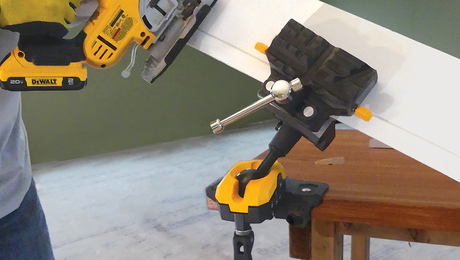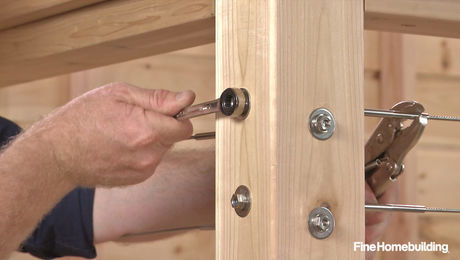*
I’m in the middle of doing 300 square feet of cobble wood flooring, inspired by a short article in FHB a year or two ago. I probably should have spent more time figuring the process out before I started.. but hindsight is 20/20 as they say..
I’m using a mixture of species- salvaged fir, salvaged hemlock, white pine, and walnut. The material is dry. I began with timber cucutoffsrom a recent timber frame job. I re-sawed the cucutoffso 5″ X I”, then cut them into 3/4″ thick “tiles”. I installed the tiles over the susub floornew construction) using parquet floor adhesive. I’ve sanded them with a commercial floor sander, and have applied 3 coats of urethane floor finish. When I installed the tiles I left 1/4″ grout joints, as recommended in the FHB article. I’m now ready to grout. The article recommended using a mixture of saw dust and Watco Danish Oil. In a closet I’ve been experimenting with the grouting process. The most effective method I’ve come up with has been to float the grout in to the joints using a ceramic tile float. The appearance seems right. Two things worry me however- will the saw dust be packed in to the joints sufficiently to withstand traffic; and will the Watco react poorly with the urethane in any way? My idea has been to wait until the Watco sets up a bit, then wipe the tiles down with t.r.p.s. After a day or so I thought I’d apply another coat of urethane to seal the whole works.
Anyone with any experience doing these floors care to tell me how bad I’m screwing this up?
Discussion Forum
Discussion Forum
Up Next
Video Shorts
Featured Story

The IQ Vise has angled jaws, a simple locking mechanism, and solid holding power.
Featured Video
How to Install Cable Rail Around Wood-Post CornersHighlights
Fine Homebuilding Magazine
- Home Group
- Antique Trader
- Arts & Crafts Homes
- Bank Note Reporter
- Cabin Life
- Cuisine at Home
- Fine Gardening
- Fine Woodworking
- Green Building Advisor
- Garden Gate
- Horticulture
- Keep Craft Alive
- Log Home Living
- Military Trader/Vehicles
- Numismatic News
- Numismaster
- Old Cars Weekly
- Old House Journal
- Period Homes
- Popular Woodworking
- Script
- ShopNotes
- Sports Collectors Digest
- Threads
- Timber Home Living
- Traditional Building
- Woodsmith
- World Coin News
- Writer's Digest


















Replies
*
I've seen floors done this way, but they were done with much thicker wood. the blocks were set as tight as they could fit and then the "grout" poured over the floor.
I'm worried about the effect of expansion with all the differant species of wood you mentioned.
In spite of that it sounds cool, good luck.
*Chris, Try this: Kris Abshire "WOOD BLOCK FLOORING REPORT" 8/8/00 5:18pmJerry
*
I'm in the middle of doing 300 square feet of cobble wood flooring, inspired by a short article in FHB a year or two ago. I probably should have spent more time figuring the process out before I started.. but hindsight is 20/20 as they say.. I'm using a mixture of species- salvaged fir, salvaged hemlock, white pine, and walnut. The material is dry. I began with timber cucutoffsrom a recent timber frame job. I re-sawed the cucutoffso 5" X I", then cut them into 3/4" thick "tiles". I installed the tiles over the susub floornew construction) using parquet floor adhesive. I've sanded them with a commercial floor sander, and have applied 3 coats of urethane floor finish. When I installed the tiles I left 1/4" grout joints, as recommended in the FHB article. I'm now ready to grout. The article recommended using a mixture of saw dust and Watco Danish Oil. In a closet I've been experimenting with the grouting process. The most effective method I've come up with has been to float the grout in to the joints using a ceramic tile float. The appearance seems right. Two things worry me however- will the saw dust be packed in to the joints sufficiently to withstand traffic; and will the Watco react poorly with the urethane in any way? My idea has been to wait until the Watco sets up a bit, then wipe the tiles down with t.r.p.s. After a day or so I thought I'd apply another coat of urethane to seal the whole works. Anyone with any experience doing these floors care to tell me how bad I'm screwing this up?